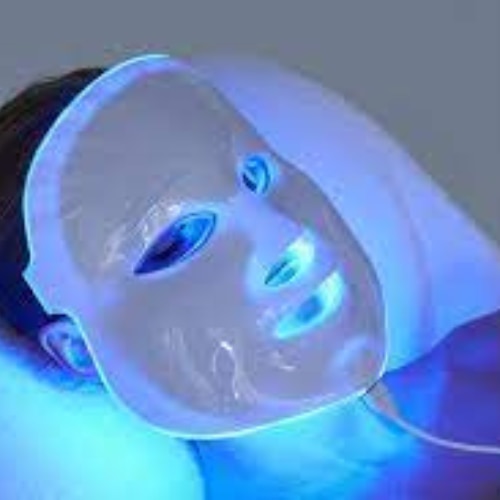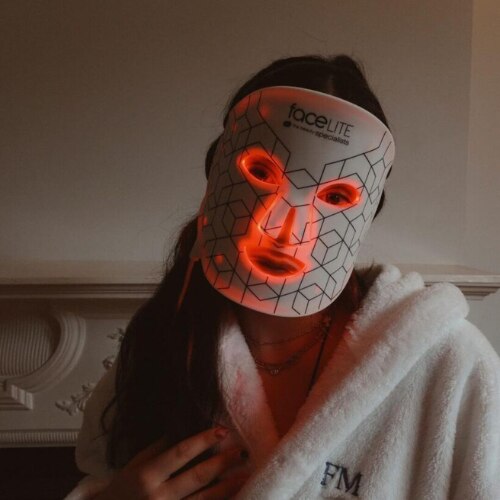
Are LED masks really good for your skin?
Two dermatologists weigh in.

You’ve probably seen your favourite celebrity wear it at home and take to the gram to let their followers know how good they feel. Yes, we’re talking about LED masks (light-emitting diode), the device that makes them look like a stormtrooper from Star Wars. While we tend to blindly follow what the stars do, it’s important to be cautious and not jump on to beauty trends yet.
How do LED masks work?
It involves the use of light in very-specific wavelengths as well as colours that help stimulate receptors in the skin. And since light is a form of energy, when it comes in contact with your skin, the cells convert it into other forms of energy that makes the skin cells healthier than before. The different wavelengths cater to different skin types and benefits.
Colour coding
Red: This light reaches deeper layers of the skin. It’s able to activate fibroblasts (cells that produce collagen—helping your skin look and feel young) in a wavelength that’s anything between 630 to 700 nanometres. This can help reduce the appearance of wrinkles and thin skin.
Red light can also help even skin tone and reduce patches of unwanted discolouration. Furthermore, stimulating the mitochondria in your facial skin cells, helps the skin look plump and more radiant. With an increase in collagen, the skin now is able to resist wrinkles and fine lines better.
On the other hand, near-infrared light, which has a wavelength between 700-1200 nanometres, has the maximum effect and penetration in the skin.

Blue: At a wavelength between 400-470 nanometres, this light has anti-inflammatory and anti-bacterial effects that’s used to treat acne. Add to that, it also helps reduce activity in the sebaceous glands—resulting in decreased production of oil that plugs pores and triggers acne. Compared to red light, blue works on the surface of the skin, and helps purify it by neutralising the bacteria that cause blemishes.
Yellow: Helps tackle and treat redness, swelling, and pigmentation when used at about 540 nanometres.
And yes, you can use different lights together at the same time. These are called combination masks: These masks typically include both red and blue LED lights, allowing for a dual-action treatment. They provide the benefits of both red and blue light therapy and are suitable for individuals with both acne and ageing concerns.
All throughout, one needs to ensure the distance between the LED lights and the skin and the duration of the light exposure is as prescribed.
The additional benefits include you not having to change your skincare routine at all. Once done with the LED treatment, you can put on some make-up and just do things the way you always did. While other treatments require you to take care of your skin to maintain it, using a LED mask requires nothing. The biggest USP is its convenience. You can use a mask anytime and anywhere.
While LED lights treat the above-mentioned issues, they don’t help with acne cysts, blackheads, and whiteheads.

It’s not for everyone
LED light therapy isn’t appropriate for everyone. This includes people who are under medication that increase their sensitivity to light and have certain conditions such as skin cancer and eye diseases. There’s also room for concern if you get a migraine or seizure due to bright light (always protect your eyes when using a LED device). If under certain antibiotics, it’s best to avoid LED light; check with your skin doctor before using it.
How to use it?
As long as you pick the right device (choose masks that are FDA-cleared) and protect your eyes, you're good to go. First, apply a serum or a photosensitizer before starting the therapy. Being exposed to blue or red light for a lengthy duration can be damaging, so always wear black or opaque goggles. Always remember to never wear any make-up during your session and apply sunscreen after every therapy.
How long does it take to see any results?
A minimum of four to six weeks (when used two to three times a week for 10 minutes per session), but probably longer, for both acne and any anti-ageing skin changes. If you’ve got wrinkles, you might have to wait a little longer to see and feel the effects.
Always remember, LED therapy is a long-term journey. Don't expect a miracle after a single session. Regular use is key to reaping the benefits.
Do dermatologists recommend it?
According to dermatologists, the use of LED masks can be beneficial for certain skin conditions. LED therapy is considered safe and non-invasive with minimal side effects. Dermatologists may recommend LED masks as part of a comprehensive skincare routine or as a complementary treatment to address specific concerns.
However, it is essential to consult with a dermatologist before using an LED mask, especially if you have any underlying skin conditions or are using other treatments. While LED masks have shown promising results, they may not be suitable for everyone, and a dermatologist can provide personalised advice, based on your skin type and concerns.
Dermatologists generally consider LED masks as safe and effective for mild to moderate skin concerns. However, it's important to note that LED masks may not produce the same results as professional LED light therapy treatments performed in a dermatologist's office.
In conclusion, LED masks are a popular at-home skincare device that uses light therapy to improve the skin's appearance. With the right knowledge and consistency, LED masks can be valuable tools in your quest for healthier, more radiant skin.While these masks can be beneficial, it is advisable to consult a dermatologist for personalised guidance and to ensure their suitability for your specific skin type and concerns.
So, if you're considering adding an LED mask to your skincare routine, it's essential to understand your skin's needs and choose the right light to target your specific concerns. Your skin's health is a priority, so choose your skincare regimen wisely and consult with a healthcare professional for personalized guidance
Inputs by Dr. Manasi Shirolikar, Consultant Dermatologist and Founder of Online Consulting Brand drmanasiskin.com, Dr Niti Gaur, MD, Fellowship in Cosmetic Dermatology (Singapore, USA), Board Certified Dermatologist Founder of Citrine Clinic, Gurgaon, Dr. Neha Khuraana, MD, a Board-certified Dermatologist and Founder, House of Aesthetics and Dr BL Jangid, Dermatologist and Hair Transplant Surgeon at SkinQure Clinic in New Delhi's Saket
.......Advertisement....
Inside Garima Garg and Devaj Jhunjhunwala’s couture-led Jaisalmer wedding
A celebration that fused self-expression with tradition, redefining how love can be seen and shared.
Bollywood siblings who make us believe in the magic of Raksha Bandhan
As we celebrate one of the sweetest festivals, here’s looking at some of our favourite iconic celebrity sibling duos to set the tone.


